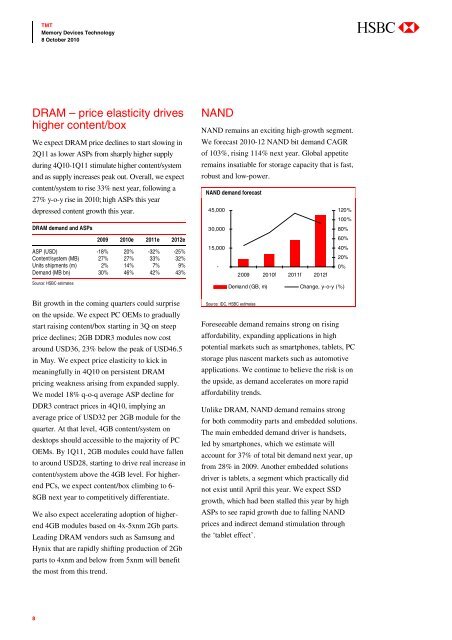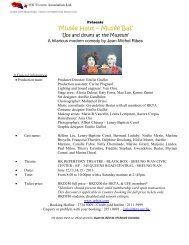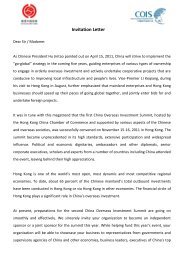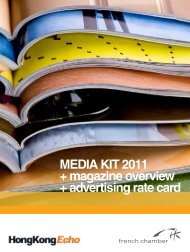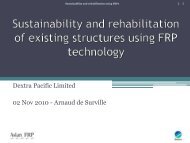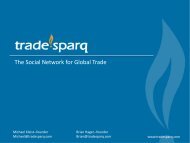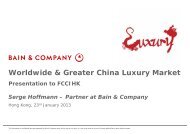You also want an ePaper? Increase the reach of your titles
YUMPU automatically turns print PDFs into web optimized ePapers that Google loves.
TMT<br />
<strong>Memory</strong> Devices Technology<br />
8 October 2010<br />
abc<br />
DRAM – price elasticity drives<br />
higher content/box<br />
We expect DRAM price declines to start slowing in<br />
2Q11 as lower ASPs from sharply higher supply<br />
during 4Q10-1Q11 stimulate higher content/system<br />
and as supply increases peak out. Overall, we expect<br />
content/system to rise 33% next year, following a<br />
27% y-o-y rise in 2010; high ASPs this year<br />
depressed content growth this year.<br />
DRAM demand and ASPs<br />
2009 2010e 2011e 2012e<br />
ASP (USD) -18% 20% -32% -25%<br />
Content/system (MB) 27% 27% 33% 32%<br />
Units shipments (m) 2% 14% 7% 9%<br />
Demand (MB bn) 30% 46% 42% 43%<br />
Source: HSBC estimates<br />
Bit growth in the coming quarters could surprise<br />
on the upside. We expect PC OEMs to gradually<br />
start raising content/box starting in 3Q on steep<br />
price declines; 2GB DDR3 modules now cost<br />
around USD36, 23% below the peak of USD46.5<br />
in May. We expect price elasticity to kick in<br />
meaningfully in 4Q10 on persistent DRAM<br />
pricing weakness arising from expanded supply.<br />
We model 18% q-o-q average ASP decline for<br />
DDR3 contract prices in 4Q10, implying an<br />
average price of USD32 per 2GB module for the<br />
quarter. At that level, 4GB content/system on<br />
desktops should accessible to the majority of PC<br />
OEMs. By 1Q11, 2GB modules could have fallen<br />
to around USD28, starting to drive real increase in<br />
content/system above the 4GB level. For higherend<br />
PCs, we expect content/box climbing to 6-<br />
8GB next year to competitively differentiate.<br />
We also expect accelerating adoption of higherend<br />
4GB modules based on 4x-5xnm 2Gb parts.<br />
Leading DRAM vendors such as Samsung and<br />
Hynix that are rapidly shifting production of 2Gb<br />
parts to 4xnm and below from 5xnm will benefit<br />
the most from this trend.<br />
NAND<br />
NAND remains an exciting high-growth segment.<br />
We forecast 2010-12 NAND bit demand CAGR<br />
of 103%, rising 114% next year. Global appetite<br />
remains insatiable for storage capacity that is fast,<br />
robust and low-power.<br />
NAND demand forecast<br />
45,000<br />
120%<br />
100%<br />
30,000<br />
80%<br />
60%<br />
15,000<br />
40%<br />
20%<br />
-<br />
0%<br />
2009 2010f 2011f 2012f<br />
Demand ( GB, m) Change, y-o-y (%)<br />
Source: IDC, HSBC estimates<br />
Foreseeable demand remains strong on rising<br />
affordability, expanding applications in high<br />
potential markets such as smartphones, tablets, PC<br />
storage plus nascent markets such as automotive<br />
applications. We continue to believe the risk is on<br />
the upside, as demand accelerates on more rapid<br />
affordability trends.<br />
Unlike DRAM, NAND demand remains strong<br />
for both commodity parts and embedded solutions.<br />
The main embedded demand driver is handsets,<br />
led by smartphones, which we estimate will<br />
account for 37% of total bit demand next year, up<br />
from 28% in 2009. Another embedded solutions<br />
driver is tablets, a segment which practically did<br />
not exist until April this year. We expect SSD<br />
growth, which had been stalled this year by high<br />
ASPs to see rapid growth due to falling NAND<br />
prices and indirect demand stimulation through<br />
the ‘tablet effect’.<br />
8


